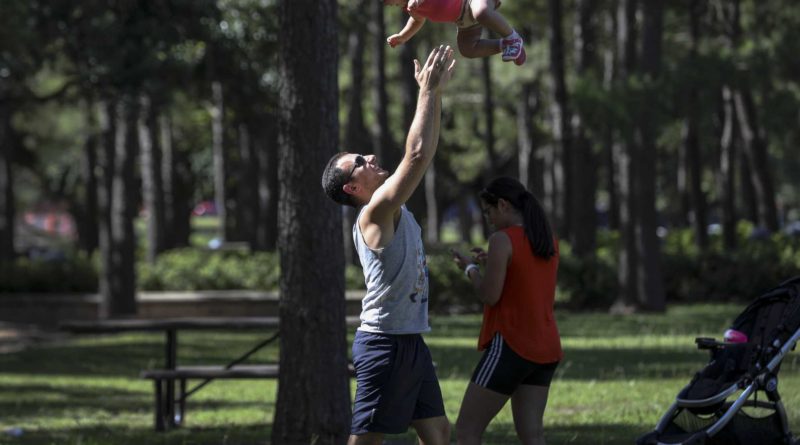Houston’s hot weather alone is not likely to squelch COVID-19
Houston’s hot weather held unusual anticipation this year: Maybe, just maybe, rising temperatures would squelch COVID-19 like it does the flu. And then, after spending much of March and April indoors, people could go to the beach, attend family barbecues and resume some normalcy.
The weather arrived and people ventured out — but COVID-19 is anything but squashed. The Houston region, as well as other parts of the country already submersed in summer weather, has seen an increase in cases.
COVID-19 is a new disease caused by a new coronavirus, and researchers still have a lot to learn. Weather and climate has been (and will continue to be) the subject of studies, papers and conversations, but thus far it appears summer alone will not stop this year’s spread of COVID-19.
More on Houston’s increase in cases: COVID-19 cases, hospitalizations spiking in Houston
“There may be some mitigating effects of warmer temperatures, humidity and sunlight, and there are some studies in the laboratory and some epidemiological studies that support that,” said Dr. Peter Hotez, professor and dean for the National School of Tropical Medicine at Baylor College of Medicine. “But how important climate will be is still unknown, and what we have to rely on is the actual data showing that we are seeing increases now in cases and hospitalizations in Houston, in Phoenix and it looks like possibly across the American Southwest.”
Houston weather has seen highs in the 90s since June 2, according to National Weather Service readings from Bush Intercontinental and Hobby airports. Phoenix highs topped 100 degrees from May 26 to June 5.
And since Memorial Day, Texas has seen a 42 percent increase in hospitalizations due to COVID-19, according to data released Wednesday by the Texas Department of State Health Services.
The seven-day rolling average of new cases in Texas was 1,574.3 on Tuesday, up from the rolling average of 1,445.4 a week earlier. In the Houston region, that rolling average was 385.6 as of Tuesday, up from 331 on June 2.
The Institute for Health Metrics and Evaluation, a global health research organization at the University of Washington School of Medicine, provides COVID-19 projections by examining factors that include temperature, mobility, population density, public transportation, people wearing masks and proper social distancing.
IHME believes there is some seasonality to COVID-19, meaning it wanes in warmer weather. But this is being overshadowed by other factors such as people gathering in groups and not wearing masks, it found by comparing those factors now with the same factors earlier in the year.
“If we had this increase in mobility earlier, it would have been much worse than now with warmer weather,” said Ali Mokdad, chief strategy officer for population health at the University of Washington and one of the faculty members who helped develop the IHME model that has been cited by the White House.
Mokdad said the seasonality of COVID-19 is more like pneumonia than the flu as pneumonia has a more gradual decline in spring and summer cases. The flu tends to see a sharper drop-off.
And despite some states seeing stagnant or increasing numbers of infected residents, IHME data as of Monday show an overall gradual decline in estimated COVID-19 infections nationwide.
Still, Hotez finds the recent increases concerning. He said it’s important to understand why cases are spiking — and if they’re going to be sustained or just temporary — “and not rely on the warmer weather and sunlight to protect us.”
Dr. Francis Collins, director of the U.S. National Institutes of Health, also suggested that warm weather won’t be enough to dramatically lower the number of COVID-19 cases. In a blog post he said “there have been hints from lab experiments that increased temperature and humidity may reduce the viability” of the new coronavirus that causes COVID-19, but that data won’t be available for a few months.
“For now, many researchers have their doubts that the COVID-19 pandemic will enter a needed summertime lull,” Collins said.
More on the new coronavirus and climate: Does climate change play a role in infectious diseases like COVID-19?
He cited studies led by researchers at Princeton University that found humans’ lack of immunity to the virus (not the weather) will likely be a primary factor driving the new coronavirus’ spread this summer and into the fall.
“New viruses have a temporary but important advantage — few or no individuals in the population are immune to them,” added Marc Lipsitch, director of the Center for Communicable Disease Dynamics at Harvard University’s T.H. Chan School of Public Health, in his own written response to this weather question. “Old viruses, which have been in the population for longer, operate on a thinner margin — most individuals are immune, and they have to make do with transmitting among the few who aren’t. In simple terms, viruses that have been around for a long time can make a living — spread through the population — only when the conditions are the most favorable, in this case in winter.”
Jordan Rubio contributed. andrea.leinfelder@chron.com
twitter.com/a_leinfelder




